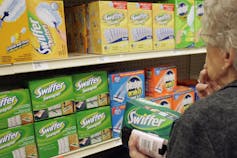
Are you eager to steer your career, team or organization toward uncharted territory? Or do you aspire to solve complex societal problems through innovation? It turns out that the most successful innovators aren’t solitary geniuses.
Instead, they excel by “spanning boundaries” — moving beyond a given particular niche to access different forms of knowledge, communities, interest groups or disciplines.
Successful innovators also maintain an “open” mindset, connecting with diverse sources of knowledge beyond their immediate networks. Openness, in the context of innovation, entails relying not just on internal knowledge and capabilities, but also incorporating external knowledge and sharing internal knowledge with the outside world.
Innovators and businesses can use social media in different ways to drive openness, and ultimately foster innovation.
Success due to openness
Numerous ground-breaking innovations owe their success to adapting ideas based on different contexts. Consider:
the assembly line technology for making cars, which Henry Ford observed and adapted from visiting meat packing facilities;
the operational innovations in pharmaceutical facilities that are learned from Formula One race car teams;
the Dyson bagless vacuum that was inspired by the cyclone in a sawmill.

Research demonstrates that individuals skilled in effectively connecting with diverse sources of knowledge beyond their immediate networks possess a better capacity to identify and solve problems, develop innovative solutions and thrive amidst complexity and change.
Collaboration with external expertise
As a business school professor studying innovation, with colleagues I have researched social media as a technology that allows people to cross boundaries, and to enhance personal and organizational impacts.
Consider Apple’s collaboration with major music labels, which culminated in the launch of the revolutionary iTunes Store, transforming music distribution and consumption.

Similarly, consumer goods giant Procter & Gamble (P&G) achieved notable success by developing a platform for P&G employees to collaborate with individuals, companies and research institutes around the world. Its successes include Swiffer dusters and Glad ForceFlex garbage bags.
By tapping into external expertise and ideas, P&G accelerated innovation and efficiently introduced radical new products to the market.
Leveraging social media
Social media platforms allow people and organizations to cross boundaries in two ways: to discover, assess and acquire new sources of knowledge, and to learn how to adapt and use the new knowledge for innovation projects.
With Marcel Bogers, a professor of open and collaborative innovation, I developed a framework comprising four social media approaches: observer, connector, promoter and influencer.
These approaches are ways to effectively span boundaries and engage in different levels of open innovation. They extend beyond mere marketing and empower innovators and their organizations to expand their networks, foster knowledge exchange and enhance learning.
Observer approach
The observer approach represents the most passive and limited form of openness. It involves using social media to monitor trends and events, ensuring comprehensive information coverage and up-to-date knowledge.
While this approach primarily focuses on framing and investigating innovation possibilities, it serves as a stepping stone toward other approaches.
Nike used social media to observe public opinion and behaviour toward NFL player Colin Kaepernick who knelt during the national anthem at the start of NFL games to protest racial injustice in the United States.
The information from this observation then guided Nike’s related branding and product development activities related to its endorsement of Kaepernick.

Connector approach
Building upon the observer approach, the connector approach is less passive and more open. It goes beyond monitoring and involves actively finding, connecting with and conversing with stakeholders such as customers, suppliers and potential partners.
This engagement is vital for framing, developing and promoting activities. Using online platforms, NASA formulated and announced challenges for optimizing human health and performance in spaceflight.
These challenges connected NASA scientists to a diverse array of expertise, both amateur and professional, resulting in innovations such as better forecasting of solar storms.
Promoter approach
The promoter approach is more active, using social media to gain visibility and recognition for innovators and their work. It revolves around broadcasting rather than listening, effectively conveying innovation progress and standing.
However, it must be executed appropriately to avoid appearing as innovation narcissism. For instance, Tesla CEO Elon Musk, who now also owns Twitter, has faced criticism for using Twitter to promote and help increase the value of Dogecoin, the cryptocurrency Tesla accepts for its pioneering direct purchase of cars.

Influencer approach
The influencer approach is the most active and open of the four. It involves leveraging social media to network, frame problems and opportunities, investigate, disseminate information and assess impact.
Influencers actively engage with those who experience and tackle societal challenges, to develop and champion innovation to address these challenges.
Clothing and outdoor gear company Patagonia’s YouTube channel hosts a video entitled “Why Patagonia is Fighting for Public Lands.” The company influences by using social media to showcase and get feedback on its actions and product innovations.
Multiple approaches over time
Boundary-spanning innovators serve as knowledge brokers, adept at sourcing, evaluating and applying adaptable knowledge to society’s problems. These innovators may adopt multiple approaches concurrently or transition between them over time.
Each approach offers distinct benefits. While the observer and connector approaches can yield incremental benefits, for ground-breaking changes, all four approaches are necessary at different stages to discover and harness novel resources, knowledge and collaborations.
Don’t neglect risks
Given the power of using social media to cross boundaries and connect with new sources of knowledge, these approaches also come with risks, especially the promoter and influencer approaches.
Musk has faced legal problems from promoting Dogecoin. The Gillette shaver advertisement that called out toxic masculinity resulted in highly split opinion online and little innovation value.
So when using social media to drive innovation, make sure you are guided by a worthy innovation mission, and don’t neglect rigor, integrity and nuance before you open up your innovation to the world.
Ian McCarthy does not work for, consult, own shares in or receive funding from any company or organization that would benefit from this article, and has disclosed no relevant affiliations beyond their academic appointment.
This article was originally published on The Conversation. Read the original article.







